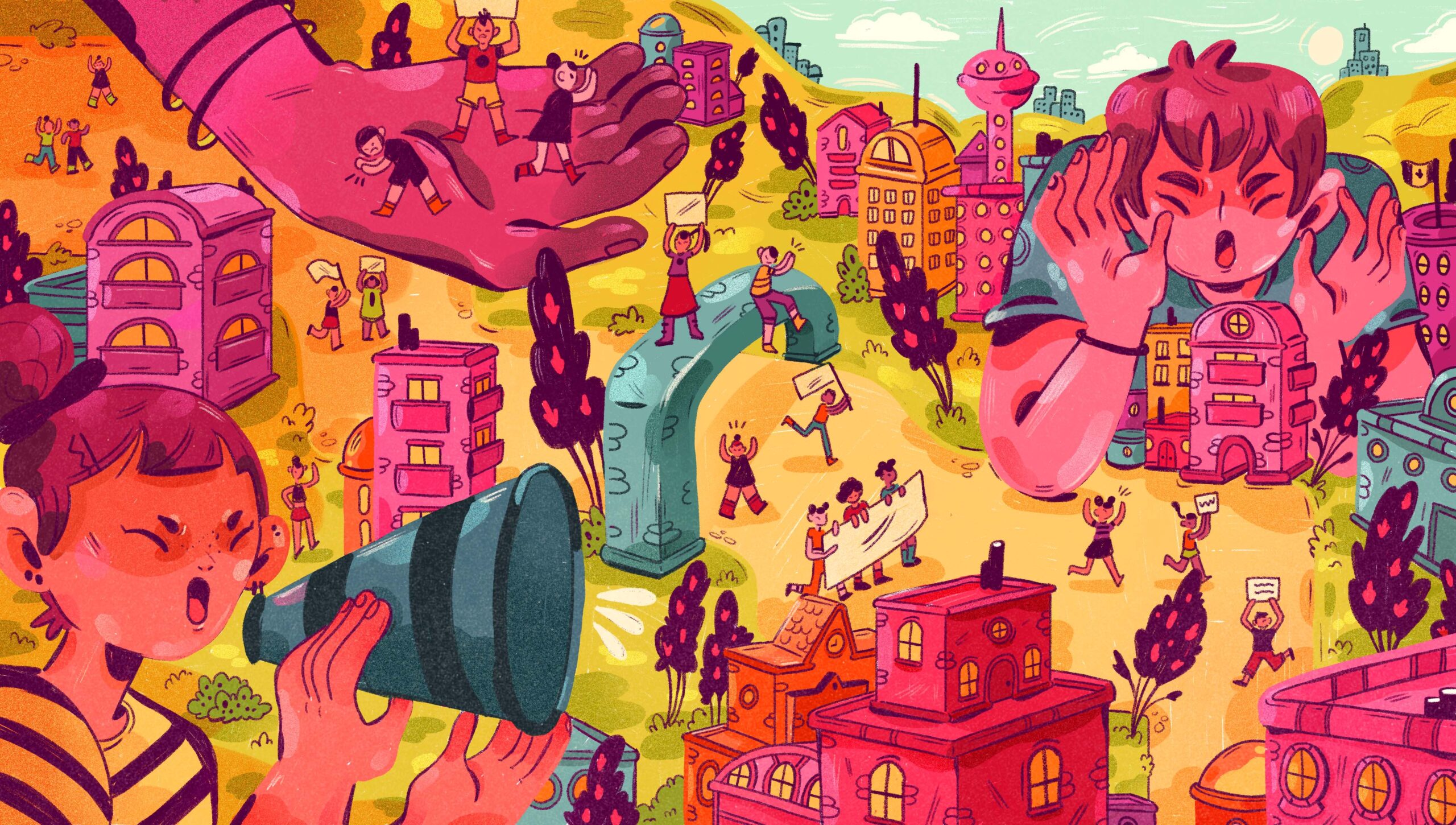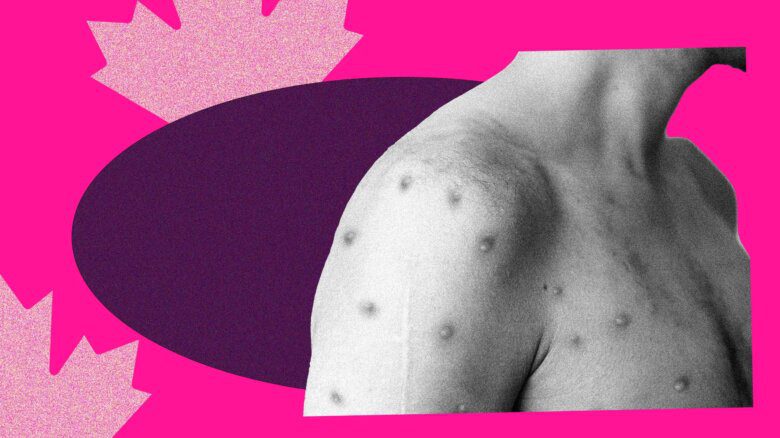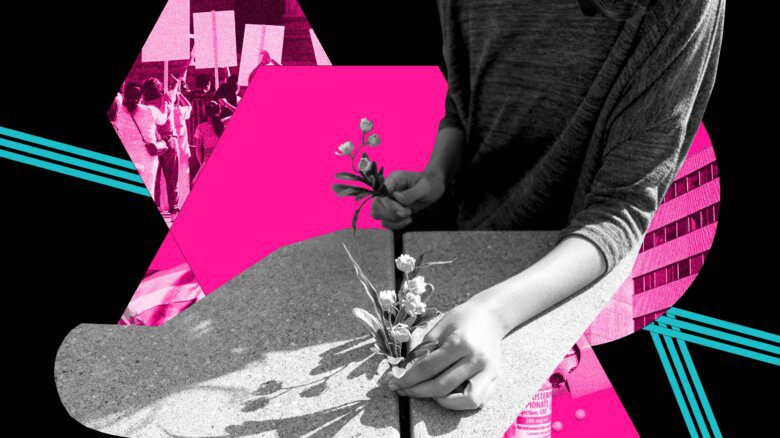This story is part of Seeing Red, a month-long series exploring periods from an LGBTQ2 perspective.
In 2015, a new wave of period activism confronted the corporate vision of baby-blue-liquid leaks with actual blood. Artist and poet Rupi Kaur, 22 at the time, posted a photo of herself lying in bed clad in a T-shirt and sweats, the visible blood stain on her pants artfully mirrored onto her sheets. The Instagram photo was part of a school project Kaur put together to challenge the disgust levelled at period blood in mainstream culture, and to point out the banality of the scene. Yet Instagram deemed the photo inappropriate for its platform and deleted it twice, citing a violation of its terms of service.
Kaur had a message for those squeamish about the reality that a large portion of the population bleeds regularly: It’s perfectly normal. “We menstruate and they see it as dirty. Attention seeking. Sick. A burden. As if this process is less natural than breathing,” she wrote in a Facebook post after the photo was deleted.
In the years since, the Western world has been thrust into an era of energized period activism. In the spring of 2015, American musician Kiran Gandhi tackled period stigma by free-bleeding through the London marathon. The #EndPeriodPlastic campaign, launched in the UK last year, is one of the many bids to make period products more sustainable. There’s also been a push to use more inclusive language to recognize that non-binary individuals and trans men menstruate; gender-neutral language like “people with periods” and “menstruators” is being adopted by healthcare providers like Planned Parenthood.
This activism runs parallel to efforts in other parts of the world, such as the work of Arunachalam “Padman” Muruganantham, an inventor in India whose innovations have provided low-cost pads to a country where an estimated four out of five menstruators don’t have access to period products. There’s also the governmental push to ban menstrual huts in Nepal after the deaths of multiple women and some children, and the LGBTQ2 protestors who risked prosecution in an attempt to reduce period stigma in Kazakhstan.
But most of the world still isn’t set up to accommodate periods. According to one Dutch study, menstrual bleeding can last between three and eight days for 35 years of cycles — that’s about 2,100 days of being on your period, roughly equivalent to six years of your life. And yet menstruation is treated as an interruption — as though it’s an unwanted visitor rather than a regular guest.
And just like in other areas of gender inequality, women have long been expected to take on the cost of accommodating this guest on their own. That means that millions of menstruators in Canada and around the world struggle to afford period products. It also means that our culture doesn’t take women’s pain seriously enough to offer proper diagnoses or menstrual leave. Thanks to the work of campaigns and petitions, some progress is finally being made in alleviating period poverty. But when it comes to the issue of period pain, there’s a lot of work that still needs to be done.
As periods seemed to become more visible in 2015, Canada finally dropped the Goods and Services Tax (GST) on menstrual products. It certainly wasn’t a pioneering move — Kenya was the first country to lift its tax in 2004. It took years of hard-fought activism in Canada for menstrual products to be considered as essential as other items that aren’t taxed, like hearing aids, milk and, somehow, androcentric prescription drugs like Viagra.
Still, a five percent drop in price doesn’t put a dent in the period poverty some people continue to face. According to a survey done by Plan International Canada last year, a third of Canadian women under 25 report they can’t afford menstrual products, which one estimate totals to just over $65 a year before tax. And that doesn’t cover related expenses — painkillers, replacing stained underwear, taking unpaid time off work to deal with intense cramping — that are all part of the invisible cost of managing menstruation.
There’s also more work to be done to recognize that the cost of products can fluctuate wildly depending on where you live, especially in northern communities. Two years ago, in Saskatoon, community organizer Nicole White read a CBC story about how young people in northern Saskatchewan were missing school because they couldn’t afford menstrual products. That spurred her to found Moon Time Sisters, an organization focused on collecting menstrual products and distributing them to communities in northern and remote areas throughout the province. Moon Time Sisters collected 96,000 products in its first drive.
Now in its third year, the organization delivers products to over 25 communities and now has a chapter in Ontario. And while White’s a fan of sustainable options, she says that single-use products are more practical for the population she works with: “I was very quickly taught that we can’t always just provide something like [menstrual] cups, because we know water quality on many reserves is really awful.”
Providing inclusive access to menstrual products is a big part of Phil Jang’s work at the Red Dot Project, which delivers tampons and pads to those without housing in Toronto. Jang and his fellow volunteers don’t track who exactly uses their products, or what brought them to their circumstances. He is, though, acutely aware that rates of homelessness among LGBTQ2 youth in Canada are 25 to 40 percent. “We don’t really ask too many questions because we need to build a lot more trust before we get to that point,” says Jang, adding one of the only questions he asks is: “Is this for you?”
While individual efforts like Jang’s and White’s address particular communities, public institutions are starting to assume the responsibility of providing products like tampons and pads. In 2016, New York City passed a law that requires menstrual products be offered free of charge in public schools, jails and shelters. This past March, Toronto city council decided that free menstrual products would be provided to shelters, drop-in centres and respite centres run by the municipality.
“Menstrual equity is an important part of a larger goal — to bring a gender equity lens to governmental budget processes,” councillor Kristyn Wong-Tam wrote in a statement ahead of the March 7 vote. “It is important that we continue the conversation about equitable investment in programs and services accessed by women, girls, trans and non-binary individuals. We must analyze and address the hidden financial inequities that are causing women and their families to be left behind.”
In April, British Columbia’s provincial government announced it would become the first in Canada to require all of its public schools be equipped with free menstrual products for students. That same month, Centennial College in Toronto announced it would become the first college in the country to provide pads and tampons in its campus washrooms without requiring a quarter. (The college is planning to install dispensers in every washroom, regardless of gender.) According to Centennial, 90 percent of their students receive financial assistance, which means this small change is poised to make a huge difference in tackling period poverty at the school.
While period poverty has become more visible to those who don’t experience it, the issue of period pain remains largely hidden. Heavy bleeding and discomfort often go unreported as a result of the shame felt around periods, or because of the normalization of period pain. When those experiencing pain do seek help, health-care providers may discount it — a challenge that’s greater still for trans and non-binary people.
One in 10 menstruators are diagnosed with endometriosis, a condition that can cause severe pain during menstruation, including pelvic pain and cramping as well as heavy bleeding — all of which can last for days after a period. Premenstrual dysphoric disorder, or PMDD, is an extreme version of PMS experienced by three to eight percent of the population that menstruate. Its symptoms can include extreme moodiness, anxiety or a sense of hopelessness or intense irritability, and the condition may require antidepressants to treat. About one in five of those with PMDD experience dysmenorrhea, pain endured one to two days before a period which can be accompanied by fatigue, nausea, vomiting and diarrhea.
An estimated 10 to 30 percent of those who experience dysmenorrhea lost one to two working days each month, according to a 2015 review of studies, though the authors note that those numbers are largely seen to be underreported.
Dr Sukhbir Singh, an Ottawa-based gynecologist, attributes the underreporting of menstrual symptoms to the normalization of pain: people may dismiss their symptoms because their relatives have had similar ones, or they may come from a culture where talking about periods is taboo, so they suffer in silence under the assumption that their pain is common. This culture of normalization can extend to physicians as well, who may not consider the impact of menstrual pain on a patient’s quality of life.
The unwillingness or inability to take menstrual discomfort seriously is part of a much broader phenomenon of discounting women’s pain. “Women are more likely to seek treatment for chronic pain, but are also more likely to be inadequately treated by health-care providers, who, at least initially, discount women’s verbal pain reports,” wrote Diane E Hoffmann and Anita J Tarzian in a 2001 review of studies on the topic. A 2009 review echoed Hoffmann and Tarzian’s findings: women report more frequent and intense pain than men, but are less likely to be treated as well for their pain.
A major consequence of the normalization of pain is the delay in getting a diagnosis — for pelvic pain or painful periods it can take up to seven years, Singh says. And for those who are trans or non-binary, there can be greater barriers to diagnosis and treatment. “It becomes even more of a challenge when there’s a fear that the medical system may not believe that your heavy periods are a problem, or that they may not even understand who you are as an individual,” Singh says.
Singh receives many requests from patients who need help getting period pain-related work leave approved, but he finds it difficult to qualify that pain on corporate HR forms that don’t have an obvious box to tick off. “The bigger issue is that society needs to accept [severe period pain] is not just about an injured muscle or a bone” which will eventually recover, Singh says.
Those forms are often designed for sick leave, but for people struggling with severe pain short-term leave may not be an option — taking time off every month could eat up an employee’s sick days for the whole year. Which is another way Canada is behind: Many countries already provide menstrual leave, including Zambia, South Korea, Japan, Taiwan and Indonesia.
The length of leave varies from country to country, but a common thread throughout these policies is the recognition that period leave should be distinct from sick leave. Japan has had this enshrined in law since 1947, giving those who suffer “heavily” the option to take days off (although the legislation leaves it up to individual employers to determine how many days and whether they will be paid). A South Korean law, introduced in 2001, permits one unpaid day off of work per month. In 2015, Zambia became the first African country to offer menstrual leave, which is also limited to one day a month.
In North America, menstrual leave is barely on our radar. The only visible evidence of activism in Canada is a Change.org petition with 176 signatures and counting — a relatively insignificant number compared to the more than 74,000 signatures on the tampon tax petition. Perhaps it’s unsurprising, given the silence around period pain even at the doctor’s office. And then there’s the reality of most workplaces: 51 percent of American men surveyed by Thinx in 2017 believe it’s inappropriate for those who menstruate to talk about it at work, while 71 percent of American women report that they’ve hidden their tampon or pad from view on the way to the bathroom.
A period leave policy on its own isn’t enough to combat this stigma; it’s been widely reported that women in Japan, South Korea and Indonesia are hesitant to take this time off because they don’t want to speak to male bosses about their periods, or because they think they’ll be penalized for it. But for Chella Quint, an educator in Britain and founder of the #periodpositive campaign, the value of a specific menstrual policy is that we would be openly talking about it — a start to ending menstrual taboos. “The fundamental benefit of writing a menstrual leave policy and putting it in your staff handbook is that anyone who reads it immediately knows that this is a workplace that talks about menstruation,” she says.
Amanda Laird, Toronto-based author of Heavy Flow, adds that menstrual leave has the potential to start a broader conversation about more human-centred workplaces. “The policies that could be applied for menstrual leave or menstruation would actually serve everybody better,” she says. “We would all benefit from having a flexible work culture.”

This story is part of Seeing Red, a month-long series exploring periods from an LGBTQ2 perspective.


 Why you can trust Xtra
Why you can trust Xtra


